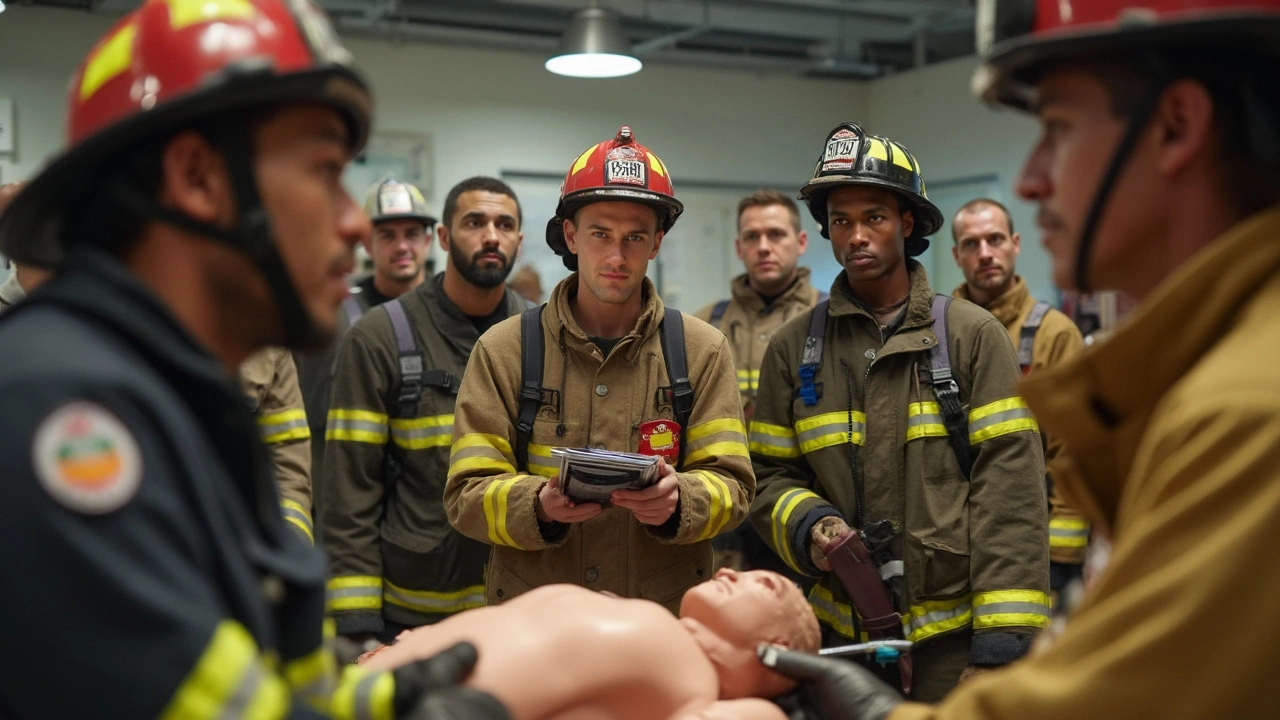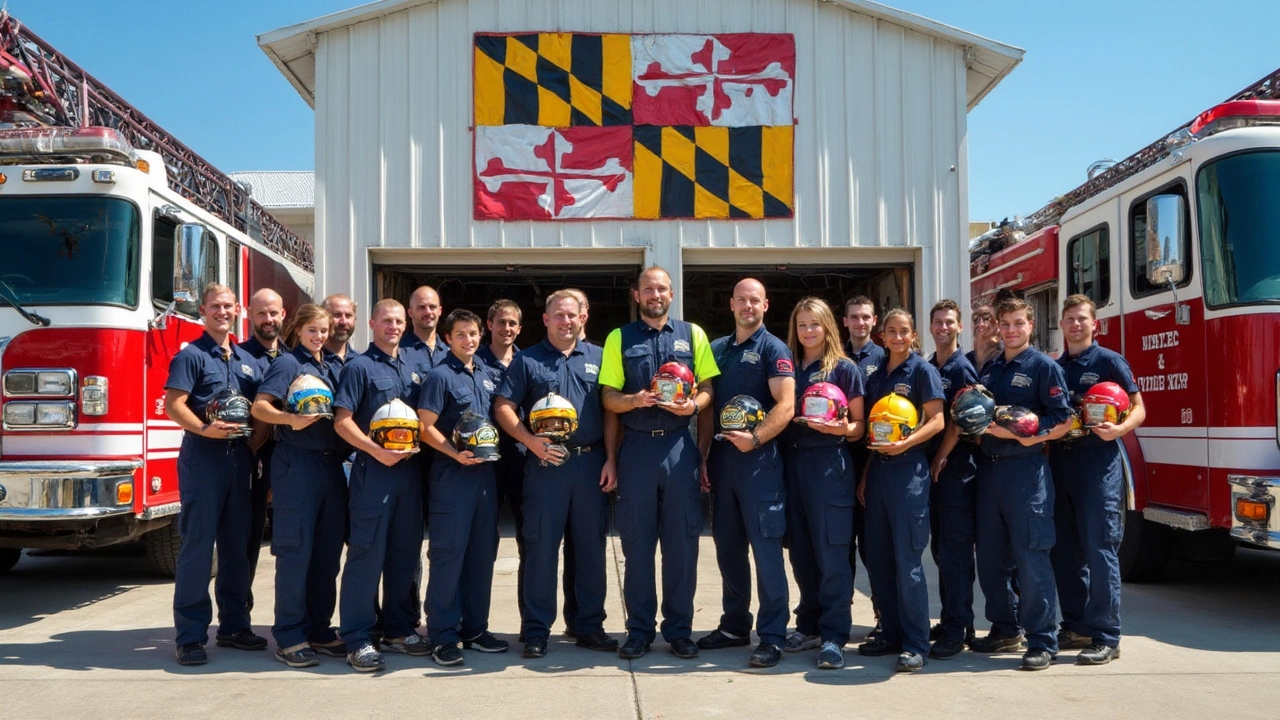Want to be a firefighter in Maryland? The rules are pretty clear, but they're strict too. First off, you can't just walk in and fill out a form. Most departments want you to be at least 18 years old, have a high school diploma or GED, and be able to prove you're a U.S. citizen or have legal permission to work here.
Physical fitness isn't just a buzzword—it's a deal breaker. If you can't run, lift, or handle serious physical stress, you won't make it past the testing phase. Think of it like training for a big game, not just working out for looks. Departments use a test called the CPAT (Candidate Physical Ability Test) to weed out folks who aren't ready.
- Age, Education, and Basic Eligibility
- Physical Fitness and Medical Standards
- Background Checks and Legal Requirements
- Fire Academy and Training Process
- Certifications and Special Requirements
- Tips to Stand Out as a Candidate
Age, Education, and Basic Eligibility
So, you’re thinking about joining the ranks as a firefighter in Maryland? Let’s get straight to the nuts and bolts. First up: age. You need to be at least 18 years old on the day you apply. No shortcuts—if you’re 17 and fired up, you’ll have to wait until that next birthday.
Next, education. Maryland fire departments want to see a high school diploma or GED. Not just for show, either. Firefighters handle technical equipment, write reports, and communicate with the public. No diploma, no dice. Some departments even prefer if you’ve picked up college credits or trade school certificates, but that’s not a must everywhere.
You also need to prove you’re legally allowed to work in the U.S. They’ll want documentation—usually a Social Security card, birth certificate, or green card. If you can’t prove your status, you won’t move forward in the process.
Here’s a quick breakdown so you can check yourself:
- Must be 18 years or older
- Hold a high school diploma or GED
- U.S. citizenship or legal right to work
- Valid driver’s license (most departments require a Maryland license before your final hiring step)
Some counties set you up with bonus points if you served in the military, have EMT or paramedic certification ahead of time, or speak a second language fluently. Not required, but definitely helps.
| Requirement | Minimum Standard |
|---|---|
| Age | 18 years old |
| Education | High school diploma or GED |
| Legal Status | U.S. citizen or legal worker |
| Driver’s License | Maryland or valid out-of-state license |
One more heads up: If you want to join as a volunteer firefighter, some towns let you start at 16, but paid positions stick tight to the 18+ rule. Don’t fudge the years. They check.
Physical Fitness and Medical Standards
If you want to be a firefighter in Maryland, your fitness level can make or break your chances. Departments depend on people who can handle real emergencies—think dragging hoses, lifting gear, climbing ladders, and pulling people out of tough spots. That’s why the CPAT (Candidate Physical Ability Test) pops up in pretty much every department’s hiring process.
Now, the CPAT isn’t your average gym class. You get eight tough events packed into less than 10 minutes. Here’s what you’re up against:
- Stair climb with a weighted vest (to mimic gear)
- Hoseline drag
- Equipment carry
- Ladder raise and extension
- Forcible entry simulation
- Search crawl through tight spaces
- Rescue drag (pulling a 165-pound dummy)
- Ceiling breach and pull
This test isn’t just to see if you get winded—it’s to check if your body can handle the demanding stuff without blowing out your knees or back. You only pass if you finish every section under the time limit, without missing any events.
Physical fitness isn’t the only hurdle, though. You’ll also have to go through a medical checkup. Departments usually follow the NFPA 1582 guidelines, which look at your heart health, lung capacity, vision, hearing, and overall strength. If you have certain medical conditions—like uncontrolled asthma, serious heart disease, or color blindness—you might be disqualified for safety reasons.
Departments want to make sure you’re not just strong for now, but ready to handle years on the job. If you’re thinking about applying, it’s smart to start strength and cardio training well in advance. Some folks even take practice CPAT tests or train with a group to see how they stack up before the main event.
Background Checks and Legal Requirements
Getting hired as a firefighter in Maryland means letting someone dig deep into your history. They’re not just checking if you’ve ever jaywalked—departments care about your driving record, criminal background, and even your financial responsibility. It’s all about proving you can be trusted, on and off the job.
Almost every Maryland fire department runs a full criminal background check. Felony convictions will pretty much stop you in your tracks. Misdemeanors—especially ones involving violence, drugs, or theft—are red flags too. Some departments might look at the type of offense, how long ago it happened, and if you’ve turned things around. But honesty is huge; if you try to hide something, you’re out.
Driving history matters more than you’d think. If you’ve picked up DUIs, reckless driving charges, or have a suspended license, that’s a big problem. After all, you’ll be behind the wheel of a heavy-duty fire engine. Departments want safe, responsible drivers.
There’s also a check on legal work authorization. You’ll need to show proof that you can work legally in the U.S. Most places ask for a Social Security card or other government ID as part of the process.
Here’s a quick rundown of what Maryland fire departments usually check:
- Criminal record (local, state, and federal)
- Driving record (all states you’ve lived in)
- Drug screening (usually urine test, sometimes hair follicle)
- Proof of legal work authorization (citizen or permanent resident)
- Reference checks (sometimes your neighbors get a call)
Some departments will also dig into your credit report. If there are signs of fraud, unpaid debts, or recent bankruptcies, you might need to explain what happened and what you’re doing to fix things.
To give you an idea of what you’ll go through, check out this table with typical hiring checks by Maryland fire departments (based on 2024 data):
| Check Type | Required By | Automatic Disqualifier? |
|---|---|---|
| Felony conviction | All departments | Yes |
| Misdemeanor (violent/drug/theft) | Most departments | Often |
| Multiple moving violations (last 3 years) | All departments | Usually |
| Failed drug test | All departments | Yes |
| No work authorization | All departments | Yes |
Pro tip: Be upfront about your history when asked—lying will get you dropped faster than almost anything else. If you have a minor offense in the past, explain how you’ve moved forward. People make mistakes, but fire departments want to see growth, responsibility, and trustworthiness.

Fire Academy and Training Process
Once you’ve cleared the first hurdles, you’ll need to graduate from a fire academy recognized by the state. Maryland usually sends new hires or recruits to the Maryland Fire and Rescue Institute (MFRI), which is part of the University of Maryland. This isn’t a quick class or a one-week bootcamp. Most entry-level firefighter training lasts at least 14-16 weeks, packed with hands-on skills, live-fire drills, and classroom study.
At the academy, expect your schedule to look a lot like a really tough, full-time job. You’ll run drills, learn how to use firefighting equipment, practice search-and-rescue, and handle hazardous materials. A typical day isn’t spent sitting around—most training blocks include time in full gear, tackling hoses and ladders, or dragging rescue dummies. There’s also homework on fire science, safety protocols, and emergency medical response.
Passing the academy isn’t automatic. You’ll have to score well on both written tests and practical skills evaluations. If you don’t meet the mark, you’re not moving on to the station, simple as that. One cool thing: almost every academy also provides firefighter Maryland trainees with Emergency Medical Technician (EMT) instruction, since most fire departments expect you to know at least the basics of emergency medicine.
Here’s a quick breakdown of what you might cover each week:
| Week | Main Focus |
|---|---|
| 1-2 | Orientation, physical training, safety skills |
| 3-5 | Fire behavior, extinguishers, equipment handling |
| 6-8 | Search and rescue, ladders, ventilation |
| 9-12 | Hazmat awareness, live fire training, teamwork |
| 13-16 | Emergency medical training, test prep, graduation |
After the academy, you’ll usually spend months on probation when you reach your station. Don’t expect the pressure to let up—Maryland fire chiefs like seeing new firefighters hustling, learning, and proving they can handle the real thing out in the field.
Certifications and Special Requirements
If you’re set on being a firefighter in Maryland, you’ll need more than just grit and good intentions. The must-have credential for almost every fire department is the Emergency Medical Technician (EMT) certification. The firefighter Maryland scene expects you to handle medical emergencies as much as fires. Some departments will let you get your EMT after you're hired, but most prefer (or flat out require) you to show up already certified.
Here's what you should expect to tackle if you want to land and keep a spot:
- EMT Certification: This one’s non-negotiable. Sign up for a state-approved course—usually 4-6 months long. There’s classroom stuff, hands-on skills, and a big test at the end. Don’t forget: your certification has to stay valid throughout your career.
- Maryland Firefighter I & II (NFPA 1001): State and county departments want you to complete these courses. They cover all the basics: firefighting tactics, rescue, and HazMat operations. Firefighter I is about 120 hours, Firefighter II adds 60 more.
- CPR Certification: Most hiring managers want current CPR credentials from the American Heart Association or Red Cross.
- Hazardous Materials Training: A basic HazMat certificate—usually included in Firefighter I—proves you can safely handle chemical emergencies.
Some departments have extra requirements (especially in bigger cities):
- Paramedic Certification: More jobs are opening up for firefighter/paramedics, especially in Baltimore and Montgomery County.
- Valid Maryland Driver's License: No DUIs, and some firehouses want a CDL (Commercial Driver’s License) if you’ll be driving the engine or ambulance.
If you’re curious about the numbers, this table sums up what’s usually required:
| Certification | Required? | Typical Duration | Renewal Needed? |
|---|---|---|---|
| EMT-Basic | Yes | 4-6 months | Every 2 years |
| CPR | Yes | 4-8 hours | Every 2 years |
| Firefighter I | Yes | 3-4 months | No |
| Firefighter II | Preferred | 1-2 months | No |
| HazMat Awareness | Yes | Included in FF I | No |
| Paramedic | Optional | 1-2 years | Every 2 years |
If you're going after a suburban or smaller rural team, they might even help you get some of these certifications after you’re on the roster. But if you’re aiming for a big city or want to move up fast, come prepared. It shows you’re serious and saves everyone time.
Tips to Stand Out as a Candidate
Getting your foot in the door as a firefighter Maryland hopeful means doing more than just passing the basics. Hiring panels see a lot of applications, so you want yours to float to the top. Here’s how you can really grab their attention.
- Get EMT Certified Early: Most Maryland departments require Emergency Medical Technician (EMT) certification anyway, but don’t wait for the fire academy. Knock it out on your own. The Maryland Institute for Emergency Medical Services Systems (MIEMSS) offers approved courses year-round.
- Volunteer: Almost half of Maryland’s firefighters are volunteers. Volunteering with your local department shows real dedication. You’ll learn the ropes, build confidence, and make valuable connections.
- Keep Your Record Squeaky Clean: Background checks are tough. Don’t get caught with problems like DUIs, major traffic violations, or recent drug use. Fix what you can before you apply.
- Train Like It’s a Job: The CPAT isn’t easy, and the physical standards don’t stop there. Run, lift, carry heavy stuff, and practice using actual fire gear if you can access it.
- Ace the Interview: Maryland fire departments love people who can think on their feet and work well with others. Practice answering scenario questions. Be ready to talk about why you care about the community.
- Prep for the Written Test: The written parts cover reading comprehension, math, and mechanical reasoning. Use online prep resources, especially ones focused on fire service tests.
Here’s a quick look at ways candidates go above and beyond, according to Maryland Fire Chiefs Association hiring feedback:
| Advantage | How Many Maryland Candidates Do This |
|---|---|
| Already EMT Certified | 65% |
| Active Volunteer Firefighter | 48% |
| Physical Test Score Over 90% | 25% |
| Military or Related Service | 18% |
Having more than one of these can really boost your chances.
“The candidates with a year or more volunteer experience and EMT in hand always jump to the top of my interview list,” says Lt. Chris Steward, Recruitment Officer for Prince George’s County Fire/EMS.
Last tip—show up on time and dress like you mean it. Presentation matters more than most people think. If you treat every step like a real job interview, you’ll set yourself apart from folks just going through the motions.





Write a comment